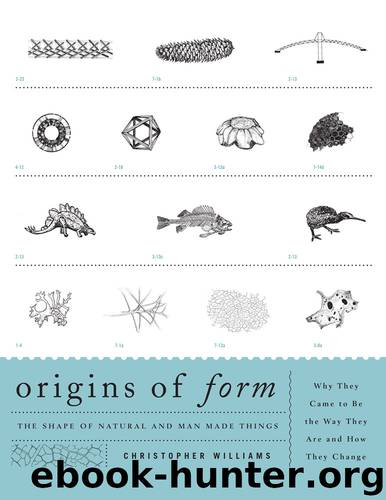Origins of Form by Williams Christopher

Author:Williams, Christopher
Language: eng
Format: epub
ISBN: 978-1-58979-936-3
Publisher: TAYLOR TRADE PUBLISHING
4-8 A and B A form and a function can undergo drastic change while the process that makes the function possible can remain essentially the same. Shown here in five steps is the evolution of a process through many forms and functions. The process: rotary motion caused by a moving flexible belt. The hunter’s bow was the probable ancestor of the bow drill. It was discovered that a slack bow string could be twisted about a spindle and moved back and forth to produce a spinning action. The rotating spindle had been used previously between the palms of the hand. The bow drill was used to bore holes and kindle fires, and it is still in use in some parts of the world. This process was then transferred to a slightly more sophisticated version, shown in the third illustration. The pump drill was held between two hands, and the horizontal bar was pulled down to unwrap the cord and spin the shaft. Momentum then wound the cord in the opposite direction and the action was repeated. The hemisphere, usually a gourd, was filled with pebbles as a flywheel. The process was then changed slightly, but with profound effect. These first examples show discontinuous rotary motion, a spinning in one direction, stopping, and a spinning in the other direction. When the flexible belt was connected to itself in a loop, the rotation became continous in one direction. The main purpose of continuous rotary motion is to transfer motion from one place to another and increase or decrease speed and power. This process has become an important part of modem technology.
There are many plants and animals that have remained unchanged through vast stretches of time while the environment about them has been in constant renewal and modification. These few enduring species were highly successful from the beginning and so little refinement was required to keep them functioning and competitive. There are some highly successful man-made designs which endure remarkably well in our society. All successful forms have economy as a common factor. All forms, natural and human, that express economy seem to be the enduring ones. An economical form is one that gets the most from the least effort and energy expended, least material used, and offers the maximum return of work. Economy then becomes a key factor. But in accepting this premise, we must leave the notion that economy is only used where it must be used. It is a misconception to think that economic design is used only when something is lacking and nothing better can be afforded. Economy means efficiency. An efficient design is geared as precisely as possible to its use. All the elements work as efficiently as can be expected.
The bowline knot is one such design. When one rope is joined to another or a loop is tied at the end of a line, experienced sailors use the bowline knot which will offer them the security of knowing that it won’t slip, and yet, when wanted, will come untied with ease, no matter how much it has been tightened.
Download
This site does not store any files on its server. We only index and link to content provided by other sites. Please contact the content providers to delete copyright contents if any and email us, we'll remove relevant links or contents immediately.
| Automotive | Engineering |
| Transportation |
Whiskies Galore by Ian Buxton(41524)
Introduction to Aircraft Design (Cambridge Aerospace Series) by John P. Fielding(32883)
Small Unmanned Fixed-wing Aircraft Design by Andrew J. Keane Andras Sobester James P. Scanlan & András Sóbester & James P. Scanlan(32569)
Craft Beer for the Homebrewer by Michael Agnew(17927)
Turbulence by E. J. Noyes(7690)
The Complete Stick Figure Physics Tutorials by Allen Sarah(7135)
Kaplan MCAT General Chemistry Review by Kaplan(6589)
The Thirst by Nesbo Jo(6432)
Bad Blood by John Carreyrou(6271)
Modelling of Convective Heat and Mass Transfer in Rotating Flows by Igor V. Shevchuk(6219)
Learning SQL by Alan Beaulieu(6029)
Weapons of Math Destruction by Cathy O'Neil(5822)
Man-made Catastrophes and Risk Information Concealment by Dmitry Chernov & Didier Sornette(5641)
Digital Minimalism by Cal Newport;(5388)
Life 3.0: Being Human in the Age of Artificial Intelligence by Tegmark Max(5182)
iGen by Jean M. Twenge(5155)
Secrets of Antigravity Propulsion: Tesla, UFOs, and Classified Aerospace Technology by Ph.D. Paul A. Laviolette(4974)
Design of Trajectory Optimization Approach for Space Maneuver Vehicle Skip Entry Problems by Runqi Chai & Al Savvaris & Antonios Tsourdos & Senchun Chai(4837)
Electronic Devices & Circuits by Jacob Millman & Christos C. Halkias(4739)
